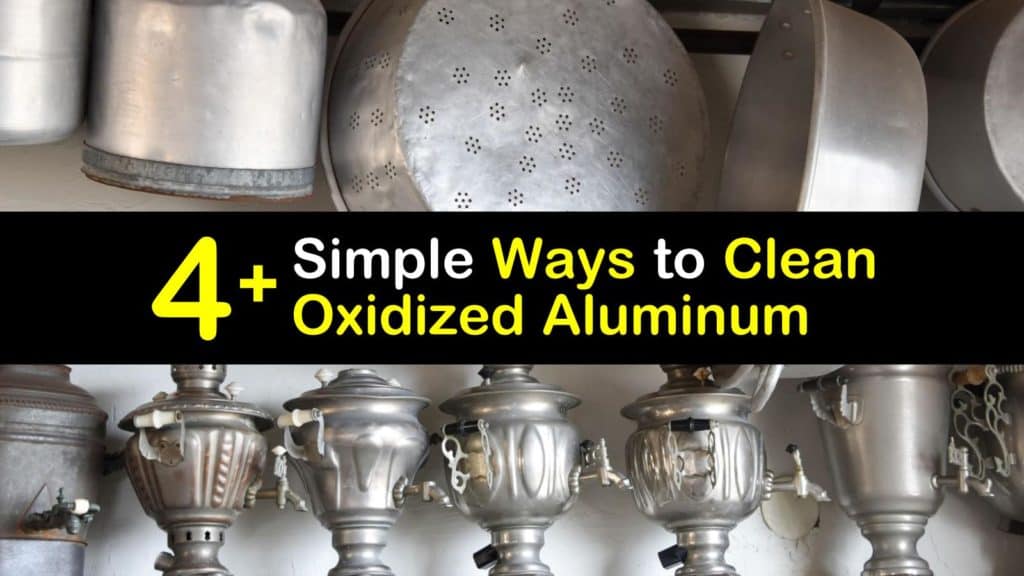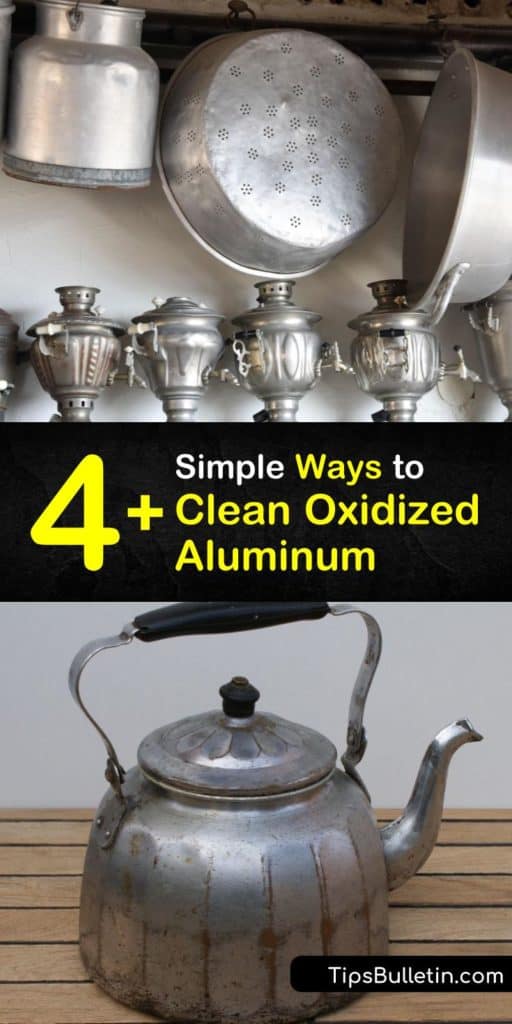Aluminum is one of our most commonly used metals and is especially true for homeowners using an aluminum pot, pan, outdoor furniture, car parts, utensils, and sinks. This metal corrodes over time, which makes knowing how to clean oxidized aluminum something that you’ll have to figure out sooner or later.
When you learn how to remove oxidation from aluminum, you take the first step toward extending product life. You pay good money for such essential metals, and the last thing you want to do is throw money at something that could have been prevented in the first place.
Aluminum has a naturally soft exterior. Because of this, aluminum is regularly mixed with copper, magnesium, and other metals that create an alloy capable of standing up to the wear and tear of everyday use. This alloy is standard for most metals, but, over time, metals acquire a dull appearance from reacting with oxygen.

What is Oxidized Aluminum?
Removing the tarnish requires specific handling instructions to ensure you don’t scratch or discolor the metals. After reading this article, you’ll quickly learn how to clean aluminum oxidation. Many people refer to rusting or corroding when they think of oxidized metals. Rust and corrosion are often interchanged but mean two different things.
Rust is corrosion that refers to iron and steel oxidation, specifically when coming in contact with moisture. Corrosion refers to the general wearing away of metals from a chemical reaction.
Because aluminum doesn’t contain iron or steel, it doesn’t rust. The corrosion process called oxidation refers specifically to aluminum.
This corrosion results in something called aluminum oxide, a powdery white, chalky coating that forms on the surface of the aluminum in an attempt to protect it from further corrosion. At this point, the metal is anodized.

Whatever you call it, rust or oxidation, we have some great ideas to clean rust off aluminum surfaces with household ingredients you likely have on hand already.
How to Clean Oxidized Aluminum
An aluminum cleaner is necessary to prevent pitting. Pitting is a type of corrosion localized on aluminum parts that eventually creates small holes in the metal.
What’s the point of having aluminum products if you allow this to happen? Taking care of your metals pays off and saves you money in the long run.
Regular Cleaning Routine for Aluminum
Get in the habit of giving your aluminum a thorough clean after each use or whenever you start to notice oxidation occurring. Be on the lookout for small white spots, discoloration, and grime that becomes increasingly hard to get rid of.
To clean anodized aluminum pot or pan, rinse it under a steady stream of water. If you’re cleaning other things like aluminum wheels, use a wet microfiber cloth or hose to rinse it.
If it still has spots, fill or cover the aluminum with very hot water. Add several drops of strong dish soap and mix until you have soapy water. Let soak for up to an hour.
Use a flat-edge spatula for scrubbing away the heavy oxidation spots until the aluminum looks free from anodized marks. This technique requires putting in a little elbow grease.
How to Remove Oxidation from Aluminum Naturally
White vinegar is one of our favorite natural cleaning agents for aluminum parts. The uses for distilled white vinegar are endless for homeowners and DIY cleaning projects.
With the power of this strong yet safe aluminum cleaning product, discover how to remove oxidation from aluminum in the simplest way, from cleaning aluminum pontoons with vinegar to your favorite pots and pans.
Fill an aluminum pot with water and add two tablespoons of vinegar for each quart of water added. Bring the combination to a boil. Let the solution boil for 15 minutes and pour the liquid down the sink.
Use a soft-bristle brush to scrub the vinegar off the aluminum surface and lift the oxidation marks. Do not use steel wool or start sanding with sandpaper on metals like aluminum and stainless steel, or you’ll scratch and damage them permanently.
Use this mixture as the best way to clean aluminum window frames, as well. Wear gloves to protect your hands from the hot water.
How to Clean Aluminum Oxidation with Lemon Juice
The acid from lemons is strong enough to tackle oxidation and for cleaning aluminum. Combine this with a natural ingredient like salt and make a simple aluminum polish and cleanser.
Cut a lemon in half and dip one of the halves in a pile of salt. Use the lemon to begin scrubbing the aluminum product. Dip the lemon in salt as many times as necessary.
For an even deeper clean, try boiling lemon slices in water for 15 minutes and then rinsing the metal. This method works similarly to the vinegar-based process while making your house smell citrusy and clean.
Use lemon and salt to clean rust from patio furniture that has become dull with overexposure to the elements. The aluminum will shine again.
Utilizing Cream of Tartar on Oxidation
Cream of tartar is something many of us have and rarely use. Cream of tartar is an acidic byproduct from the process of making wine. The acid works like lemon juice to break down oxidation.
Pour some cream of tartar in a small bowl and add hydrogen peroxide until paste forms. Dip the microfiber cloth in the paste and rub it on the surface of the aluminum. Let sit for ten minutes.
Rinse the cloth and then use it to scrub away the paste from the bare aluminum. Wash the aluminum as usual and let dry completely before using it again. Substitute baking soda if you don’t have cream of tartar.
Use Commercial Cleaners
There are tons of aluminum cleaners on the market that easily remove oxidation. If you go this route, ensure the metal polish is specifically for aluminum.
These commercial cleaners often come out as a clear coat that works as a protective coating and brightener for the metal. Use a microfiber cloth and begin buffing the product into the aluminum.
Knowing how to clean aluminum oxidation is a tool that is guaranteed to come in handy at some point. It doesn’t matter if you’re a homeowner or renter, nearly every person on the planet uses aluminum products when cooking, driving, or even sitting outside on patio furniture.
Aluminum is a sturdy metal that won’t go away anytime soon, so it’s best to learn how to take care of it and prolong its life for as long as possible.

If you found this article on how to clean oxidized aluminum beneficial for your metal products, please share these homemade aluminum cleaners with others on Facebook and Pinterest.